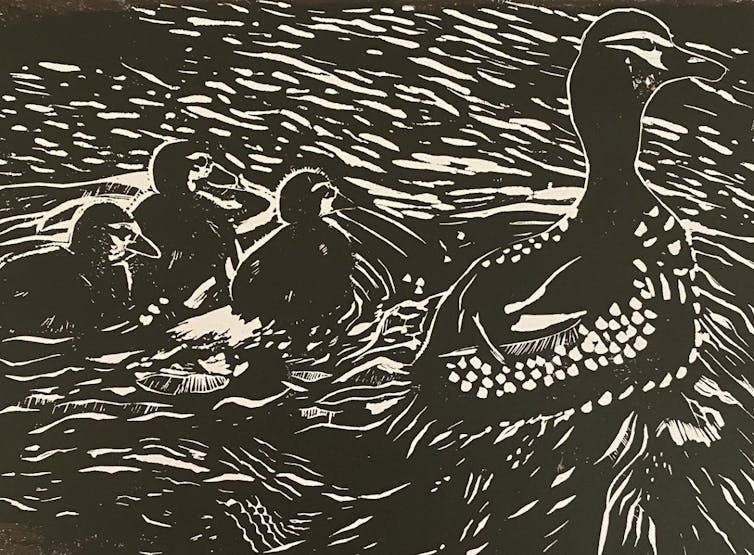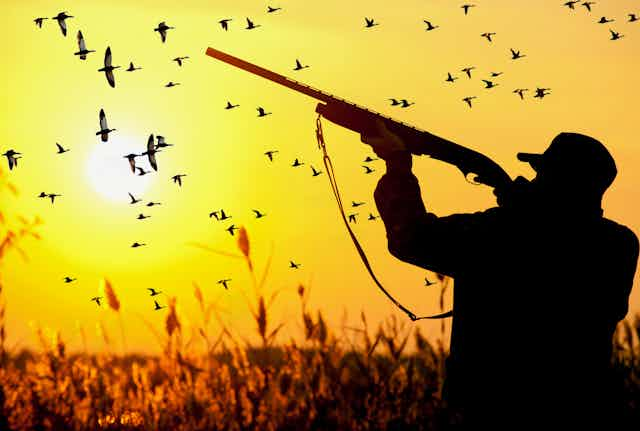The Victorian government has confirmed duck and quail hunting will continue in the state, albeit with changes which would purportedly ensure the practice “remains safe, sustainable and responsible”.
The controversial decision is a rejection of recommendations by a bipartisan parliamentary committee chaired by a Labor MP, which recommended ending native bird hunting this year.
I, along with my Elder Anthony McKnight, made a submission to the inquiry. To us as Yuin men, Yumburra (black duck) – one of the species being hunted – is a culturally significant species and our tribal totem. Yumburra is Country, we are Country. Harm to Yumburra is harm to us.
Our submission argued against recreational hunting of native birds based on concerns for the ongoing health of duck populations and questions over the ethics of the sport. We acknowledge that not all Traditional Custodians share the same position, but this is ours.

Read more: Why duck shooting season still isn't on the endangered list
Open season for controversy
Duck hunting has long been contentious in Victoria. The issue emerges every autumn when the responsible minister is set to announce the details of the shooting season. Each year the same groups come out to wade through the muddy water and thrash out the same bloody arguments.
Advocates of the sport argue it brings money into regional communities and that it has become a tradition (albeit one with a short history in the context of this old land).
But the fact remains that waterfowl populations are in long-term decline. The inquiry heard that habitat destruction is the major contributor to this trend but that hunting was likely to be a small contributing factor.
Duck hunting also causes avoidable injuries to birds. The inquiry heard non-lethal wounding rates of ducks could be as high 6-40%, or 15,700 to 105,000 based on the 2022 season.
I cannot accept such high rates of injury to a significant totem. I hunt for feral deer, species that cause great damage to Country, but I only shoot when I’m confident of a humane kill. And I fish, but I only take fish when I’m comfortable that crayfish and abalone numbers are strong on the reefs where I have swum all of my life.
In allowing duck hunting to continue, the Victorian government is ignoring the main recommendation of the committee.
The government says it will accept the other seven recommendations “in full or in principle”, by changing the rules from 2025. This includes:
- making education and training for hunters mandatory
- improving compliance and toughening penalties
- reducing the risk of wounding
- increasing recognition of Traditional Owners’ knowledge of hunting and land management.
In theory this addresses many of the problems. But in practice these measures will be resource-intensive and challenging to implement effectively. Education and compliance activities will need to be well funded and staffed. And hunting-related harm to individual ducks and populations can only be reduced, when it could have been eliminated.
Finally, these measures fail to address the issues that have been driving waterbird populations down over decades.
A disturbing pattern of behaviour
The Victorian government has form in ignoring evidence of the declining health of our environment.
In December 2021 I was invited to present an Indigenous perspective to an inquiry into ecosystem decline in Victoria. I told them of watching the decline of the manna gum woodlands I had grown up in, and how that impacted me.
That inquiry found threatened native species are suffering severe declines and are not being holistically protected. It also recommended the Victorian government consider revoking the “unprotection order” that allows dingoes, a threatened native species, to be killed over vast areas of Victorian private and public land.
Read more: 'The boss of Country', not wild dogs to kill: living with dingoes can unite communities
Three weeks afterward as part of the Independent Expert Panel reviewing the Wildlife Act, I submitted our report to the state government. The government commissioned the review because it was concerned about limitations of the laws following two high-profile cases, including the deliberate mass killing of wedge-tailed eagles, a species acknowledged by many Indigenous Victorians as the Creator.
In the two years since we submitted our report, the Victorian government has not responded nor released our report publicly.
In September last year, the Barengi Gadjin Land Council called for an end to indiscriminate killing of dingoes, a species Indigenous Australians consider kin. Just weeks later, the Victorian government extended the unprotection order for dingoes.
In October 2022 the Victorian Auditor General’s Office released a report titled Protecting Victoria’s Biodiversity. It highlighted flaws in the state environment department’s threatened species protection and the data that informed decision-making.
That report also noted the department received less than half of the funding it requested to meet its own targets. What’s more, the most recent state budget decreased spending on the environment.
So where does this get us? Late last year the Victorian State of the Environment report was quietly tabled in parliament. Among the grim findings were that biodiversity continues to decline. Most biodiversity indicators assessed had deteriorated since 2018. These declines included “waterbird species in the Murray–Darling Basin” and “distribution and abundance of waterbirds in the Murray–Darling Basin”.
Demand more from the Victorian government
The Victorian government’s support for recreational duck hunting is just one in a litany of failures to respond adequately to environment decline and to support the views of Indigenous Victorians.
The world is achingly beautiful, but that beauty is fading. It’s not fading in a faraway place, it’s happening on your doorstep, within your sphere of influence.
We, as Victorians, must accept our responsibility to care for this place that sustains us both physically and spiritually. We must demand that governments acknowledge the environment is being devastated and prioritise policies to reverse the trend. We cannot abdicate this responsibility to Country any longer.

